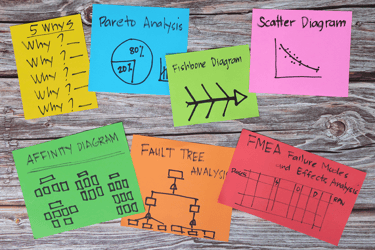The Packaging Industry's Sustainability Challenge: Why ERP Systems Are Essential for Success A straightforward guide to navigating sustainability regulations across folding carton, flexible...
What is JDF and how does it benefit packaging companies?
The packaging industry is in a constant state of evolution
With a relentless pursuit of efficiency and automation being priorities for companies striving to excel in the market. Among the most pivotal tools in this journey is the Job Definition Format (JDF), a standardized framework that has revolutionized the management of graphic processes.
In this article, we will delve into the essence of JDF, exploring its unique attributes, objectives, and the advantages it offers to the graphics industry. Furthermore, we will illuminate the seamless integration of JDF with the Radius ERP System and how this dynamic combination can elevate the efficiency and outcomes of packaging companies.
Contents
- What is JDF?
- Core concepts of JDF
- Key components of JDF
- Advantages packaging businesses can gain by embracing JDF
- Seamless integration with the Radius ERP system
What is JDF?
JDF, or Job Definition Format, stands as a standardized file format harnessed within the packaging and graphics realm to facilitate automation and seamless communication across diverse stages of the packaging production process. It is a catalyst for streamlining workflows and mitigating errors by offering a uniform framework to define print jobs.
Core concepts of JDF
- XML-Based Format: JDF files are crafted in XML (Extensible Markup Language), a universally recognized standard for data exchange.
- Hierarchical Structure: JDF documents sport a hierarchical architecture, featuring various elements representing different aspects of a print job. These encompass job particulars, resources, process steps, and more.
- Data and Instructions: Nestled within the JDF are details about the print job, including specifications, instructions, and a comprehensive breakdown of the production process.
Key components of JDF
- Production Order: This central component in a JDF file houses critical information such as job specifics, customer details, production intricacies, and other pertinent data.
- Process Steps: These delineate individual tasks or stages within the production process, each with its specific instructions, resources, and dependencies.
- Resources: Resources encompass elements indispensable to the production process, ranging from images and fonts to colors, all intricately linked to the process steps that utilize them.
- Dependencies: JDF permits the specification of interdependencies among various process steps, ensuring that tasks progress in the correct sequence.
- Layout Information: This section furnishes details concerning the print job's layout, encompassing imposition, dimensions, and any other relevant layout directives.
- Device and Equipment Information: JDF may include information pertaining to the devices and equipment engaged in the production process.
Advantages packaging businesses can gain by embracing JDF
The packaging industry can leverage JDF (Job Definition Format) to achieve the following significant benefits:
- Streamlined Process Integration: JDF acts as the linchpin uniting various stages of the graphic process, from conceptualization to printing, fostering robust communication and seamless collaboration across diverse departments.
- Consistent Quality: By furnishing a meticulous job description, JDF upholds a uniform standard of excellence across all projects, ensuring the consistent delivery of high-quality graphic products.
- Operational Agility: Adopting JDF equips packaging companies with the agility to promptly respond to customer demands, showcasing adaptability and bolstering competitiveness, which leads to customer satisfaction and loyalty.
- Drastic Error Reduction: JDF's automation significantly curtails the likelihood of human errors, enhancing production efficiency, burnishing the businesses reputation, and conserving resources.
- Enhanced Traceability: JDF empowers comprehensive tracking of each production step, offering superior quality control and valuable insights for future optimizations.
- Time and Resource Savings: JDF's intelligent automation streamlines tasks, facilitating fluid communication between printing systems, resulting in error reduction and efficiency gains. This frees up time and resources for strategic, value-added activities.
- Compatibility and Scalability: JDF is a flexible and scalable solution adaptable to packaging companies of varying sizes and complexities.
- Sustainability: JDF's process integration can contribute to resource conservation, making operations more sustainable by reducing paper and ink consumption.
As the industry continues to evolve, the role of JDF is likely to expand, incorporating new technologies and processes that further enhance efficiency and quality. Innovations such as AI-driven analytics, IoT-enabled devices, and advanced robotics could integrate seamlessly with JDF frameworks, pushing the boundaries of automation and precision in print and packaging production. Companies that stay ahead of these trends by adopting JDF and its integrations will not only enhance their operational capabilities but also position themselves as leaders in the competitive market.
Seamless integration with the Radius ERP system

The Radius ERP system is designed specifically for the carton, label and flexible packaging industries, making it the most complete ERP software solution for the packaging sector.
Integrating the Radius ERP System into the graphic workflow through the generation of JDF files is a strategy brimming with exponential benefits. This is attributable to Radius' inherent capacity to natively generate data, containing all essential information for creating requisite files. This integration delivers complete synchronization in process operations management, optimizing each production stage synergistically and efficiently.
The implementation of Radius ERP Software with JDF integration stands as a significant competitive advantage, enabling packaging and printing companies to thrive in an increasingly challenging market. Therefore, investing in this integration is an imperative stride towards ensuring success and sustainability in the graphics sector, guaranteeing a robust and efficient market position.



